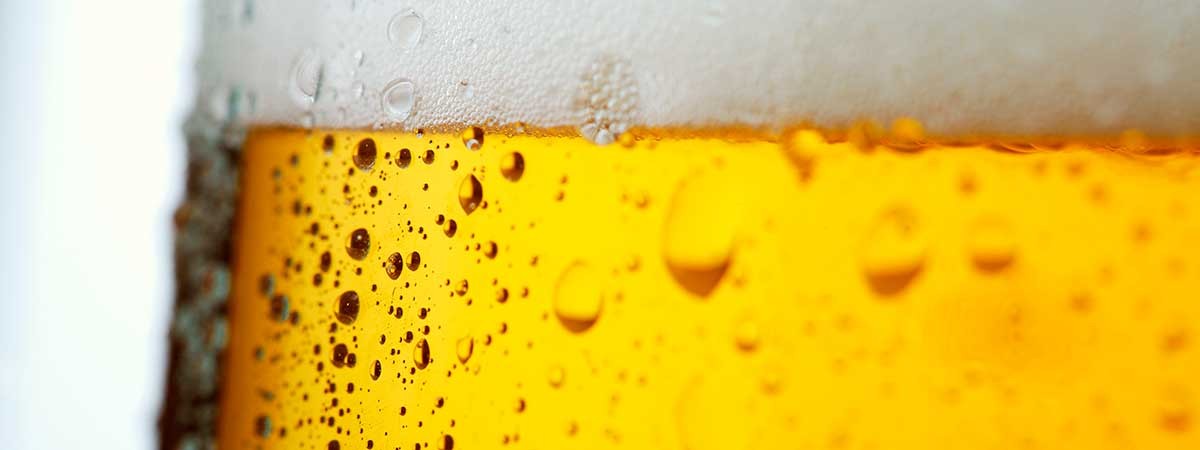Alcohol is a flavour carrier. If you remove it from beer, some of its taste is lost. This gave alcohol-free beers a bad reputation for a long time. Nowadays there are methods such as vacuum distillation that can be used to preserve the bitter taste so many people enjoy, without the alcohol.
Historians still debate whether the Chinese or the Sumerians first discovered how to brew beer – while those who enjoy the foamy thirst-quencher find this controversy unimportant. Essentially, the process used for beer production has hardly changed since the early days. The development of new, usually vacuum-supported methods was only needed once brewers started producing alcohol-free varieties.
Tasty results without alcohol
Brewing beer is basically very simple. You heat water and sprouted grains, or malt. The starch from the grain is converted into soluble malt sugar. This can then be fermented with hops and yeast. After a relatively short time, you have a beer with 3.5 to 5 percent alcohol content. Of course, there is more to brewing a truly fine beer – but we won't go into that amount of detail here.
Alcohol-free varieties were brewed the same way, at least initially. But as soon as the alcohol is removed, the taste of the beer suffers. That's why alcohol-free beer was long considered stale and tasteless, and not many people wanted to drink it. Brewers have since come up with modern methods to solve this dilemma. One of the common processes today involves halting the fermentation process using a cold shock as soon as the brew reaches an alcohol content of 0.5 percent in the fermentation tank. This tiny residual amount is enough to preserve the typical taste. Beer with up to 0.5 percent is allowed to be sold as alcohol-free in Germany, for example.
Other methods of reducing alcohol content while preserving taste are reverse osmosis and dialysis methods. In these processes, beer is pressed through fine membranes at increased pressure. These membranes can be permeated by small alcohol molecules, but not by the larger molecules responsible for carrying flavor. The process can be supported with vacuum on the other side of the membrane.
Gently removing alcohol with vacuum
Delicious alcohol-free beer can also be created with vacuum distillation. During this process, the fermented end product flows through a closed system and evaporates, as happens in any common distillation process. The trick here, however, is the vacuum in which the process takes place. This changes the boiling point of the contained ethanol so that it doesn't boil off at about 78 degrees as it does at normal pressure; instead, it already boils off at a temperature of 35 degrees. The alcohol vapor, which also contains some of the taste, is then condensed and distilled again to separate the flavors. These are then added back into the alcohol-free beer. The result is a particularly pure-tasting beverage with a distinct flavor of hops.

Full-bodied, not bland
Alcohol-free beer can pack a lot of taste, thanks to vacuum
Are people fit to drive after having a beer with 0.5 percent alcohol?
The effects that the small amount of residual alcohol in alcohol-free beer have on the body have been examined in various studies. One study concluded that a person would have to drink 15 to 20 bottles of alcohol-free beer in relatively quick succession to reach the blood alcohol level caused by one bottle of normal beer.
The University of Freiburg's Institute of Forensic Medicine in Germany came to the following conclusion: even when consumption is accelerated, the increase in blood alcohol level is irrelevant under realistic drinking conditions. In 78 trial subjects who drank 1.5 liters of alcohol-free beer within one hour, the maximum blood alcohol concentration reached 0.0056 parts per thousand. According to the summary of the study's authors, no influence on driving ability can be expected.
Incidentally, fruit juices also have a natural alcohol content of approximately 0.5 percent. Kefir has even more.
The effects that the small amount of residual alcohol in alcohol-free beer have on the body have been examined in various studies. One study concluded that a person would have to drink 15 to 20 bottles of alcohol-free beer in relatively quick succession to reach the blood alcohol level caused by one bottle of normal beer.
The University of Freiburg's Institute of Forensic Medicine in Germany came to the following conclusion: even when consumption is accelerated, the increase in blood alcohol level is irrelevant under realistic drinking conditions. In 78 trial subjects who drank 1.5 liters of alcohol-free beer within one hour, the maximum blood alcohol concentration reached 0.0056 parts per thousand. According to the summary of the study's authors, no influence on driving ability can be expected.
Incidentally, fruit juices also have a natural alcohol content of approximately 0.5 percent. Kefir has even more.